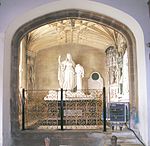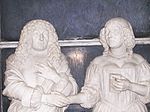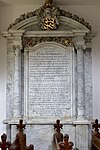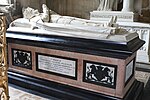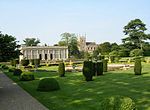
Belton House is a Grade I listed country house in the parish of Belton near Grantham in Lincolnshire, England, built between 1685 and 1687 by Sir John Brownlow, 3rd Baronet. It is surrounded by formal gardens and a series of avenues leading to follies within a larger wooded park. Belton has been described as a compilation of all that is finest of Carolean architecture, said to be the only truly vernacular style of architecture that England had produced since the Tudor period. It is considered to be a complete example of a typical English country house; the claim has even been made that Belton's principal façade was the inspiration for the modern British motorway signs which give directions to stately homes.

Henry John Cockayne-Cust, JP, DL was an English politician and editor who served as a Member of Parliament (MP) for the Unionist Party.
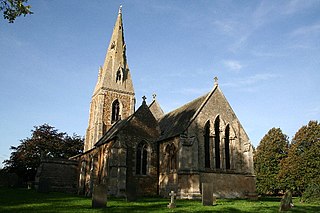
Marston is a village and civil parish in the South Kesteven district of Lincolnshire, England. The population of the civil parish at the 2011 census was 360. It lies 5 miles (8 km) north from Grantham, 8 miles (13 km) south-east from Newark, and 1.5 miles (2.4 km) north from the A1 near Long Bennington
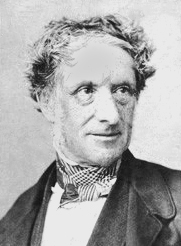
Sir Richard Westmacott was a British sculptor.
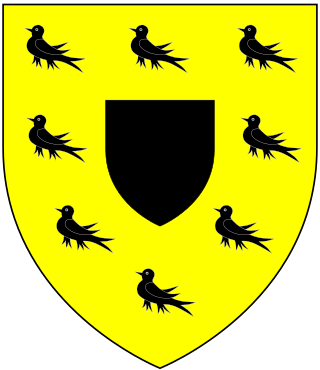
Viscount Tyrconnel was a title in the Peerage of Ireland. It was created in 1718 for Sir John Brownlow, 5th Baronet, Member of Parliament for Grantham and Lincolnshire. He was made Baron Charleville, in the County of Cork, at the same time, also in the Peerage of Ireland. The Brownlow Baronetcy, of Humby in the County of Lincolnshire, was created in the Baronetage of England on 27 July 1641 for William Brownlow. His grandson, the third Baronet, represented Grantham in Parliament. The latter had no surviving male issue and was succeeded by his younger brother, the fourth Baronet. He sat as Member of Parliament for Peterborough and Bishop's Castle. He was succeeded by his son, the aforementioned fifth Baronet, who was elevated to the Peerage of Ireland as Viscount Tyrconnel. The three titles became extinct on Lord Tyrconnel's death in 1754. The Brownlow estates were passed on to the late Viscount's nephew, Sir John Cust, 3rd Baronet, whose son was created Baron Brownlow in 1776.
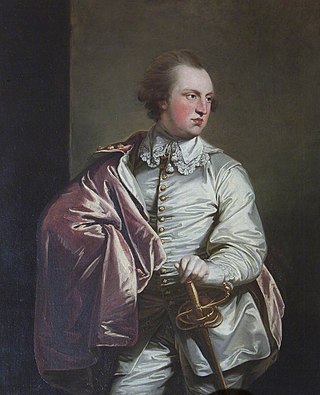
Brownlow Cust, 1st Baron Brownlow, of Belton House near Grantham in Lincolnshire, was a British Tory Member of Parliament.

Sir John Cust, 3rd Baronet PC, of Belton House near Grantham in Lincolnshire, was a British politician who served as Speaker of the House of Commons from 1761 to 1770.

There have been two baronetcies created for members of the Cust family, one in the Baronetage of England and one in the Baronetage of the United Kingdom.

John Brownlow, 1st Viscount Tyrconnel, KB, known as Sir John Brownlow, 5th Baronet, from 1701 to 1718, of Belton House near Grantham in Lincolnshire, was a British politician who sat in the House of Commons from 1713 to 1741.

Sir John Brownlow, 3rd Baronet of Belton House near Grantham in Lincolnshire, was an English member of parliament. He built the grand mansion of Belton House, which survives today.

Honington is an English village and civil parish in the South Kesteven district of Lincolnshire. It lies just north of the junction between the A153 and A607 roads, about 5.5 miles (8.9 km) north of Grantham and 8 miles (12.9 km) west of Sleaford.
Sir Henry Cheere, 1st Baronet was a renowned English sculptor and monumental mason. He was the older brother of John Cheere, also a notable sculptor.

Manthorpe is a village in the South Kesteven district of Lincolnshire, England. It is on the northern edge of the town of Grantham and on the Grantham to Lincoln A607 road, between the East Coast Main Line and the River Witham. The village is part of the civil parish of Belton and Manthorpe.
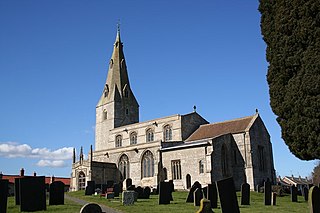
St Peter's Church is a Grade I listed Anglican parish church dedicated to Saint Peter, in Ropsley, Lincolnshire, England. The church is 5 miles (8 km) east from Grantham, and in the South Kesteven Lincolnshire Vales. St Peter's is in the ecclesiastical parish of Ropsley, and is part of the North Beltisloe Group of churches in the Deanery of Beltisloe, and the Diocese of Lincoln.
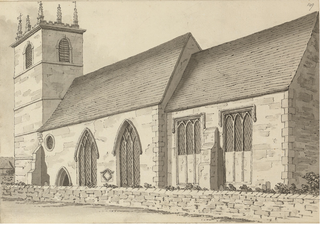
St Martin's Church was among the oldest churches in the city of Lincoln, England. It has been suggested that during the Anglo-Saxon Period and during the Danelaw, St Martin was considered to be the patron saint of Lincoln. The church is likely to have been associated with the rare St Martin silver pennies minted in Lincoln, probably before 918 A.D, when Lincoln was taken back from the Danes by the Anglo-Saxons.

The Boathouse on Boathouse Pond, Belton House, Belton, Lincolnshire was designed by Anthony Salvin in 1838–1839. It is a Grade II listed building.

Edward Browning was an English architect working in Stamford.

Richard Brownlow (1553–1638) of Belton in Lincolnshire, was a lawyer who served as Chief Prothonotary of the Court of Common Pleas.

Sir John Brownlow, 1st Baronet of Belton, near Grantham in Lincolnshire, was twice Sheriff of Lincolnshire and on 26 July 1641 was created a baronet "of Belton in the County of Lincoln". He died without progeny when his baronetcy became extinct. His monument survives in St Peter and St Paul's Church, Belton, showing half statues of himself and his wife finely sculpted in white marble.
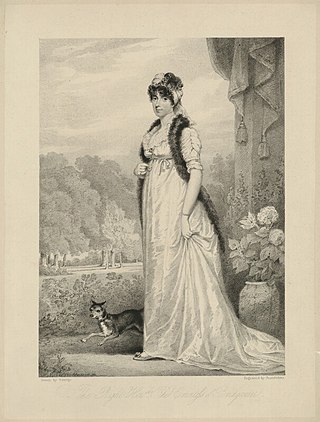
Charlotte Catherine Anne, Countess of Bridgewater, née Charlotte Haynes, was a British noblewoman. She was known for her philanthropic and charitable acts, and supported numerous educational and religious causes. She was responsible for the laying out of the ornamental gardens around her family home at Ashridge in Hertfordshire.


